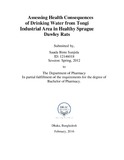| dc.contributor.advisor | Rahman, Imon | |
| dc.contributor.author | Sunjida, Sauda Binte | |
| dc.date.accessioned | 2017-02-02T07:23:30Z | |
| dc.date.available | 2017-02-02T07:23:30Z | |
| dc.date.copyright | 2016 | |
| dc.date.issued | 2016-02 | |
| dc.identifier.other | ID 12146018 | |
| dc.identifier.uri | http://hdl.handle.net/10361/7726 | |
| dc.description | This project report is submitted in a partial fulfillment of the requirements for the degree of Bachelor of Pharmacy, 2016 | en_US |
| dc.description | Cataloged from PDF version of project report. | |
| dc.description | Includes bibliographical references (page 49-54). | |
| dc.description.abstract | Bangladesh has plentiful sources of drinking water from river and groundwater but due to the rapid industrialization and development processes the quality of drinking water is being deteriorated day by day. Therefore, the safety of drinking water has always been a major concern especially in global village. This study has been undertaken to evaluate the health consequences of tongi industrial areas drinking water in healthy Sprague Dawley rats and to measure the quality of drinking water by determining the presence of some heavy metals. The experimental study was continued for 8 weeks and 18 healthy Sprague Dawley rats were assessed by their hematological, biochemical and histopathological evaluation. The heavy metals that has taken accounted in this study includes Cr, Mn, Cu, Zn, Cd, Pb, As, Ni and Se. The concentration of Mn, Cd and As was found in higher amount than the maximum allowable limits of WHO. At the end of the 8 weeks of study, the hematological parameters of the experimental rat did not show any significant changes statistically, except the value of platelets which was found to decrease significantly. The serum enzymes ALT and AST found to decrease in the experimental group and showed significant decrease of ALT enzyme which was found to indicate the presence of liver dysfunction in several studies. The histopathological observation showed mild alteration of liver, kidney and spleen tissue as compared to the control. From the overall interpretation it has been observed that the decrease of platelets and serum ALT, AST level might have some relation with the high concentration of cadmium and arsenic in the sample water and it can be demonstrated as the after-effect getting exposure with those heavy metals. Because cadmium and arsenic is found to be very toxic even in a very trace amount and from several studies it has been noticed that these metals (Cd and As) exert oxidative damage of some organs especially in liver by instigating oxidative stress which in turn follows up with the reduction of serum enzymes and in the long term caused severe kidney dysfunction and chronic liver damage. However, the overall observation of this study does not show any conspicuous findings due to the very short term of study. Therefore, in order to have a clear outcome of this study long term study of some parameters is necessary. | en_US |
| dc.description.statementofresponsibility | Sauda Binte Sunjida | |
| dc.format.extent | 54 pages | |
| dc.language.iso | en | en_US |
| dc.publisher | BRAC University | en_US |
| dc.rights | BRAC University project report are protected by copyright. They may be viewed from this source for any purpose, but reproduction or distribution in any format is prohibited without written permission. | |
| dc.subject | Drinking water | en_US |
| dc.subject | Healthy Sprague | en_US |
| dc.title | Assessing health consequences of drinking water from Tongi industrial area in healthy Sprague Dawley rats | en_US |
| dc.type | Project report | en_US |
| dc.contributor.department | Department of Pharmacy, BRAC University | |
| dc.description.degree | B. Pharmacy | |

